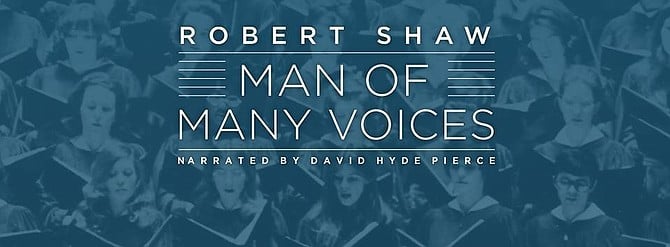 Facebook
Facebook
 X
X
 Instagram
Instagram
 TikTok
TikTok
 Youtube
Youtube

I found myself listening to the Robert Shaw Chorale over the holidays. It was a bit of a nostalgic journey as this was the soundtrack for Christmas at my grandparents' house. I also remembered that Robert Shaw had done some work with the San Diego Symphony in the early 1990s.
As I was in something of a Shaw flow when, lo and behold, I received a notification that the Choral Consortium of San Diego is hosting a screening of a recent documentary regarding the oracle of American choral singing on Saturday, January 21, at 2 p.m. and 4:30 p.m. The location is CPMA Performing Arts Theater, 5050 Conrad Avenue, San Diego, CA 92117.
I went online to find information about the documentary but quickly let the documentary be and started watching several of the YouTube videos that show Shaw working with a chorus of a few hundred choral directors from around the country.
As I watched I began to understand some of the exercises that have now become standard in American choirs. The influence of Shaw cannot be overstated. He had an ability to take a chorus from one level to the next by way of engaging their brains in a novel way.
The predominant distinction was in listening to and being aware of the pitch. Hearing Shaw explain the reasoning behind his approach made so many things fall into place. He would have the chorus count the beats out loud while singing the pitches or sing only the vowels or sing on just one repeated syllable such as noo.
I had done many of the exercises before in various choirs. I liked some of them and I found others to be a nuisance. However, now that I understand why those exercises are important I find myself looking for a choir to sing it with the hopes of doing some of the Shaw technique.
Why are those exercises important? It allows the singers to focus on less while learning and shaping a piece of music. If you are learning a piece of music and try to sing the rhythm, the pitches, and the text all correctly at the same time, it pulls most singers in too many directions.
Shaw’s techniques reduce the amount of information the brain is trying to process, which frees up bandwidth to focus on important elements — such as pitch.


I found myself listening to the Robert Shaw Chorale over the holidays. It was a bit of a nostalgic journey as this was the soundtrack for Christmas at my grandparents' house. I also remembered that Robert Shaw had done some work with the San Diego Symphony in the early 1990s.
As I was in something of a Shaw flow when, lo and behold, I received a notification that the Choral Consortium of San Diego is hosting a screening of a recent documentary regarding the oracle of American choral singing on Saturday, January 21, at 2 p.m. and 4:30 p.m. The location is CPMA Performing Arts Theater, 5050 Conrad Avenue, San Diego, CA 92117.
I went online to find information about the documentary but quickly let the documentary be and started watching several of the YouTube videos that show Shaw working with a chorus of a few hundred choral directors from around the country.
As I watched I began to understand some of the exercises that have now become standard in American choirs. The influence of Shaw cannot be overstated. He had an ability to take a chorus from one level to the next by way of engaging their brains in a novel way.
The predominant distinction was in listening to and being aware of the pitch. Hearing Shaw explain the reasoning behind his approach made so many things fall into place. He would have the chorus count the beats out loud while singing the pitches or sing only the vowels or sing on just one repeated syllable such as noo.
I had done many of the exercises before in various choirs. I liked some of them and I found others to be a nuisance. However, now that I understand why those exercises are important I find myself looking for a choir to sing it with the hopes of doing some of the Shaw technique.
Why are those exercises important? It allows the singers to focus on less while learning and shaping a piece of music. If you are learning a piece of music and try to sing the rhythm, the pitches, and the text all correctly at the same time, it pulls most singers in too many directions.
Shaw’s techniques reduce the amount of information the brain is trying to process, which frees up bandwidth to focus on important elements — such as pitch.
Comments